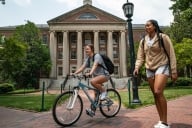You have /5 articles left.
Sign up for a free account or log in.

Prostock-Studio/Getty Images
Spring enrollment for undergraduates this year was down nearly 5 percent from last year, according to the National Student Clearinghouse Research Center. That is roughly 10 times the decline experienced from spring 2019 to spring 2020. Community colleges were the hardest hit, losing more than 9 percent of their students.
Enrollment data for the summer haven’t yet been collected and released, as some institutions are still taking sign-ups for their late-season classes. But anecdotal evidence suggests a mixed picture. While some institutions are seeing a summer enrollment surge, others are seeing comparable numbers to past years or a dip.
At Grand Rapids Community College in Michigan, for example, summer enrollment is up nearly 9 percent from last year’s session and 3.7 percent from 2019, a spokesperson for the college said. The term doesn’t start until June 29, leaving room for some additional sign-ups.
“As our area recovers from the pandemic, students are looking for new skills to change or advance their careers. We’ve worked hard to make sure a GRCC education is accessible and affordable to help people move forward,” the college said in a release. Students may also be taking advantage of expanded financial aid programs, like Michigan’s Future for Frontliners program, which offers free tuition for people who worked in essential industries during the pandemic.
At Montcalm Community College, also in Michigan, summer enrollment is up nearly 30 percent from last year and 15 percent compared to 2019, said Stacy Young, president of the college. Young credits the growth to an intentional, concerted effort by the college. An enrollment task force, a partnership with a consulting agency and a focus on Generation Z all helped to make that a reality, she said. In January 2020, the rural college had been declining in enrollment for 10 years.
Laredo College, in Texas, saw a dip in summer enrollment from 2019 to 2020 but reported that numbers are back up this year. Summer 2021 shows a 20 percent jump in enrollment over 2020.
The College of Southern Idaho has seen a tremendous jump in summer enrollment this year, with the head count up 43 percent from last year and nearly 41 percent from 2019.
“I’ve been here 27 years, and we got a new president last year. For the previous 26 years, at least, when I was here, summer has really been treated as an opportunity for students that they’re welcome to take but we didn’t really spend a lot of time actively trying to promote why taking summer courses would be a good idea,” said Chris Bragg, dean of institutional effectiveness at Southern Idaho.
Officials at the college said the administration was intentional about the summer this year and actively sought to recruit students. They opened registration early, visited dozens of high schools in the state and sent every student who enrolled a response about how many credits they could have paid for with the college’s federal funding.
The college is also seeing a jump in new students. In past years, after subtracting dual-credit students who are in high school, only 12 percent of summer enrollees were new to the institution. Now, that number has reached about 25 percent. About two-thirds of those new students are also enrolled for the fall, up from about 45 percent in past years. All of that could spell increased enrollment generally for a place like Southern Idaho.
It’s difficult to say what overarching factors could lead to increased attendance at two-year colleges this summer. Summer enrollment can help accelerate time to degree for both community college and bachelor’s degree students, which could be more important as students deal with the financial fallout of the pandemic. Students at public flagships or private universities often take summer classes at community colleges to get credits at less cost than at their home institution. As institutions begin in-person classes once again, students who have had a year of online or hybrid learning may want to jump in as soon as possible.
Not everyone has seen an enrollment bump. Mineral Area College, in Missouri, for instance reports an 8.3 percent decline in summer students compared to last year.
Among four-year colleges and universities, many institutions saw summer enrollment surge in 2020, as students saw internship and work opportunities vanish. In some cases, this year is can’t compete with last.
The University of Richmond, for example watched its undergraduate summer enrollment spike about 54 percent from 2019 to 2020. While 2019’s summer head count was 671, 2020’s was 1,035. This year the university is seeing that number come down to 797, still a more than 18 percent jump from 2019.
Harvey Mudd College in California started offering summer courses just in 2019. The first year was small, with only 48 students. In 2020, that number ballooned to 422, all in remote courses. This year, the college is still offering only online courses, but fewer of them and has seen enrollment drop to about 200.
Arizona State University saw summer enrollment surge by nearly 10,000 students from 2019 to 2020. The jump, from about 49,000 to 59,000, is a 20 percent growth. This year numbers are expected to keep growing with more sign-ups, but they currently stand at about 60,000.
Ball State University, a four-year institution, says its summer enrollment this year is comparable to that of past years. While there are some in-person classes being offered, the university is holding most classes online, as it typically does during the summer.
As college enrollment is skewing down across the country, it remains unclear whether high summer enrollment at some community colleges could be a bellwether for the fall, indicating a return to pre-pandemic head counts, and finances, for some colleges and universities.








